Abstract
In current literature, studies on indoor air quality mostly concern environments such as hospitals, schools and homes, and less so on spaces producing food, such as bakeries. However, small- and medium-sized bakeries are typical and very common food production spaces, mostly in Southern Italy. Considering this, the present study investigated size trends of the aerosol particles during bakery working activities and the indoor particulate matter PM2.5 chemical speciation at the same time, in order to characterize the aerosol particulate matter emissions. In particular, indoor air monitoring was performed using a silent sequential sampler and an optical particle counter monitor during 7–19 April 2013. For each daily sampling, four PM2.5 samples were collected. In each sample, OC (organic carbon), EC (elemental carbon), LG (levoglucosan) Cl− (chloride), NO2− (nitrite), NO3− (nitrate), SO42− (sulfate), C2O42− (oxalate), Na+ (sodium), NH4+ (ammonium), K+ (potassium), Mg2+ (magnesium) and Ca2+ (calcium) concentrations were determined. The main sources of particles were wood burning, the cleaning of ovens (ash removal) and the baking of bread. While levoglucosan was associated with the source wood burning, potassium in this case can be considered as a marker of the contribution of the bakery activities. This work represents the second part of indoor research activities performed in the bakery. The first part was published in Ielpo et al. (2018).
1. Introduction
There is growing public awareness regarding health due to the risk associated with poor indoor air quality (IAQ) in home and workplaces as humans typically spend 80–90% of their time indoors [,,,,,].
The indoor air pollution (IAP) produced by the domestic combustion of solid fuels is responsible for up to 4 million deaths annually []. Occupational asthma is a work-related respiratory disease frequently reported in many countries. Baker’s asthma can be caused by immunologic sensitization to specific work-related allergens and subsequent allergic reactions in the airways [,,,]. The inhalation of wheat flour following exposure to flour dust is the main cause of the onset of this disease/pathology in bakery workers [,,,,]. In the literature, it is well known that the exposure to wheat flour dust can determine the occurrence of diseases affecting the respiratory system []. Many studies (e.g., [,]) have documented that the exposure to flour dust and associated aeroallergen of bakers, pastry makers and mills workers during the process of flour manipulation has resulted in a variety of respiratory effects that have been described among bakers, including impairment of pulmonary function and chronic bronchitis []. Less well-known are the various risk factors present in the baking industry []. The bakeries, in fact, have always been subjected to frequent food hygiene checks, but investigations to identify and assess the risk factors occurring during work activities inside bakeries are very rare [,].
In workplaces where grain is handled, there is substantial evidence that workers develop respiratory symptoms related to high concentrations of dust micro- and macroparticulate fractions produced by various stages of the industrial process [,,,,,,,,]. In particular, bioaerosols have been widely studied in different occupational and nonoccupational settings, such as bakeries and flourmills [,].
Knowing the true extent of the risk factors is an essential requirement in order to set up and adopt a suitable and effective health protection system. The study of indoor air quality is fundamental to understand the pollutants and concentrations to which workers are exposed, and this aspect in the literature is quite unexplored.
Indoor air pollution deriving from solid fuel (biomass and coal) combustion products is a relevant public health issue, mainly in the developing world []. Several studies of indoor air quality have identified cooking and in particular cooking using biomass or wood as a heating source as one of the most significant activities that generates indoor particles [,,,,]. In fact, cooking and biomass burning emissions are among the main sources of particulate matter (PM) [,,]. Different styles of cooking generate aerosols with typical mass concentrations, size distribution and chemical compositions, and the presence of well-known chemical carcinogens, such as PAHs (polycyclic aromatic hydrocarbons). PAHs are released by incomplete combustion of organic substances [,] and regular exposure to these substances at higher levels can be a modulating factor for the susceptibility of the exposed population to pulmonary morbidity. The smoke generated during combustion is associated with a variety of cancers, the most notable being lung cancer [,]. It is worth noting that there are still observed risks to health in people exposed to cooking aerosols when they spend most of their time in environment characterized by the presence of this aerosol for professional reasons. Bakers are therefore among the workers categorized as those exposed to high PM concentrations emitted by burning wood.
In the present work, we investigated the IAQ of an artisan bakery located in the Bari province of South Italy. In particular, a high-time-resolution study of physical and chemical properties of aerosol particles (particle number, size distribution and chemical composition) in an artisan bakery of Southern Italy was carried out to provide a detailed aerosol characterization for better understanding of the indoor air quality. In this bakery, a wood-fired oven operated. The main species emitted during bakery operations (carbonaceous fraction, i.e., organic and elemental carbon, levoglucosan and main ions) were quantified. This work represents the second part of indoor research activities performed in the bakery. The first part was published by Ielpo et al. (2018) [] in which a combination of approaches were used, including analytical chemistry analyses to determine indoor PAHs concentrations, computational fluid dynamics to reconstruct the air ventilation in response to air temperature gradients within the working environment and health risk analysis to assess the risk to which the baker and coworkers were exposed.
To the best of the authors’ knowledge, no similar datasets are available for such working environments, at least not in Italy.
2. Experiments
2.1. Sampling Site
The object of this study is a bakery located in Bari province (South Italy). Details on site location, climate and planar view of the bakery are shown in Ielpo et al. (2018) []. Here, we emphasize that the bakery has characteristics that are typical for Southern Italian bakeries—it is equipped with two ovens: a gas oven that is composed of seven levels, with openings of 3.7 m2 per level and a thermal power of 80,000 kcal/h, and a wood oven with an opening of 13 m2 and a thermal power of 80,000 kcal/h. In the wood oven, oaken and olive wood and almond peelings are typically burned.
In the bakery, working activities start early in the morning, at about 3:30. Generally the first activity, a few minutes later than 3:30, is the flour housing in the kneading machine, followed by the ovens switching on around 3:50 until 5:00, for the heating phase. Afterwards, oven cleaning activities take place with ash removal. At around 5:00, the baking of rolls, sfilatino and rosetta (typical local breads) and sandwiches in the gas oven starts. It remains switched on until about 7:30. At 6:30, the wood oven is switched on again until 7:45 in order to obtain the correct temperature for bread cooking. After oven cleaning and ash removal, at around 8:00, the baking of bigger bread takes place until about 10:30. During the heating phase, almond peelings are burned every day except for Monday and Saturday during which oaken wood is used. At 6:30, when the oven is again switched on, olive wood is used every day except Friday and Saturday during which oaken wood is burned. In the oven powered by gas, small size bread is cooked. In the wood-powered oven a larger size bread is cooked.
In the afternoon, the oven powered by gas is switched on around 18:00 for cooking delicatessen products, with the time changing somewhat from day-to-day according to the daily requirements. In the bakery, about 150 kg of total flour per day is used, except for days with a major bread request.
At the end of the day, starting from 20:30 to 22:00, cleaning activities of bakery rooms and ovens (using an extractor) take place.
2.2. PM2.5 Indoor Sampling
In the bakery, a monitoring campaign was performed during 7–19 April 2013 in order to collect PM2.5 indoor samples and particle number concentration trends. In particular, indoor PM2.5 samples were collected by a sequential air sampler (SILENT Sequential Air Sampler—FAI Instruments S.r.l., Roma, Italy) for six hours on quartz fiber filters (prefired 47 mm diameter Pallflex, Pall Corporation, Port Washington, New York) equipped with sampling heads operating at a flow rate of 10 L/min with a relative uncertainty of 5% of the measured value. Four PM2.5 samples were collected every day.
Filters were weighed before and after the particulate sampling with a Genius Sartorius SE2-F analytical microbalance with a sensitivity of 0.0001 mg (Sartorius, Milan, Italy) and equipped with an ionizer for electrostatic charge abatement. The relative humidity (RH) and temperature in the weighing room were 44% ± 7% and 22 ± 3 °C and the samples were kept in these conditions for 48 h before weighing.
During the day, PM2.5 sampling intervals were from 3:00 to 9:00 (first sampling interval), from 9:00 to 13:30 (second), from 14:00 to 21:00 (third sampling interval) and from 21:00 to 3:00 (fourth). These sampling intervals were chosen in order to sample according to the different kind of activities performed in the bakery. Most of the bakery productions occur during the first and second sampling interval, together with the lighting of both gas and wood ovens. During the third sampling period, only a short lighting of the gas oven for the afternoon production and clean activities occurs. The fourth sampling interval corresponds with the closure hours of the bakery.
Four PM2.5 samples were collected every day, with a total number of 40 PM2.5 valid samples (on 7, 14 and 17 April some problems occurred with the sampling system and these filters were not considered).
The filters were cut into four pieces for the chemical analyses. On each sample OC (organic carbon), EC (elemental carbon), LG (levoglucosan) Cl− (chloride), NO2− (nitrite), NO3− (nitrate), SO42− (sulfate), C2O42− (oxalate), Na+ (sodium), NH4+ (ammonium), K+ (potassium), Mg2+ (magnesium) and Ca2+ (calcium) were quantified.
2.3. Particle Size Distribution
During the indoor monitoring campaign, in addition to the SILENT sampler, an optical particle counter (OPC) multichannel monitor (FAI Instruments, Rome, Italy) was used in order to obtain temporal trends of the particulate matter granulometric distribution. This instrument, operating with sampling flow of 1 L/min and based on laser scattering and the elliptical mirror principle, collects particle numerical counts per liter in eight optical channels with thresholds having the following lower limits: 0.28, 0.4, 0.5, 0.7, 1.1, 2.0, 3.0, 5.0 m, and a time resolution of 1 min.
The OPC monitor, using particle number concentration collected per each granulometric size, was able to estimate mass concentration of particulate matter fractions PM10, PM2.5 and PM1 by a particular parametric algorithm internal to the instruments. Before starting the campaign, the OPC was connected by serial communication with a SWAM monitor (a mass sampling device based on the attenuation method) in simultaneous sampling. In this way, it was possible to transfer PM fraction mass concentration data measured by SWAM to the OPC. By using the real data of PM fraction mass concentration, the OPC improves its mass estimations by a self-learning process that updates the parameters used in the parametric algorithm.
The OPC monitor and Silent sampler were positioned in a zone of the bakery’s laboratory with sampling heads at about 160 cm from ground.
2.4. Inorganic Components Analyses
An ICS-1000 ion chromatograph (Dionex) was used for the water-soluble inorganic constituents determination (Cl−, NO2−, NO3−, SO42−, C2O42−, Na+, NH4+, K+, Mg2+ and Ca2+). The sample was dissolved in a total Milli-Q water volume of 10 mL. The setup of the extraction procedure is described in detail in Fermo et al. (2006) a and Piazzalunga et al. (2013) [,]. All reagents were of analytical grade (Fluka, Milwaukee, WI, USA). Ultrapure water was produced by a Milli-Q system (Millipore, Bedford, MA, USA). All the ion concentrations determined were higher than the limit of detection (LOD) for this technique [].
2.5. Carbonaceous Fraction and Anhydrosugars Analysis
OC and EC mass concentrations were determined on a punch (1.5 cm2) taken from each quartz filter by thermal optical transmittance (TOT) technique (Sunset Carbon Analyzer, Tigard, Oregon) exploiting the high-temperature NIOSH (National Institute for Occupational Safety and Health) protocol [,,].
The analyses for levoglucosan (LG) were carried out after extraction from the quartz fiber filters, following the methodology described for the water soluble ions, by High-Performance Anion-Exchange Chromatography with Pulsed Amperometric Detection (HPAEC–PAD) using an ion chromatograph Dionex ICS1000 [,]. As eluent, NaOH 18 mM was used with a flow rate of 0.5 mL/min. An amperometric detector (Dionex ED50) equipped with an electrochemical cell was used [].
3. Results
3.1. PM2.5 Concentrations
As shown in Table 1, higher PM2.5 mean concentrations were found during the first and second sampling intervals.

Table 1.
PM2.5 mean concentrations for each sampling range.
The indoor total mean concentration of PM2.5 for all sampling days was 90 ± 18 g/m3. The outdoor PM2.5 mean concentration obtained from the closest air quality monitoring station of ARPA Puglia (Environmental Protection Regional Agency of Apulia) during sampling days in the bakery was 12 ± 3 g/m3 while the outdoor PM10 mean concentration was 17 ± 4 g/m3. The result that the indoor PM2.5 mean concentration was bigger than outdoor PM2.5 suggests dominant indoor sources for PM2.5.
3.2. Optical Particle Counts (OPC): Fine and Coarse Fraction Trends and Tendency of Derived Parameters
In Figure 1, PM10, PM2.5 and PM1 mass concentration trends obtained by OPC in a typical working day are shown. It is possible to observe a light increase of all the fractions starting from 4:00 that reached higher values between 5:15 and 6:00. Afterwards, concentrations decreased, even if some peaks were observed at 7:05, 8:45 and 9:10. In the early morning, all the size fractions showed lower peaks (about 200 µg/m3) at about 4:00 and larger concentrations with a maximum at more than 700 µg/m3 at about 9:00. An analogous trend was observed considering the particle number per liter for fine (0.28–1.10 µm) and coarse (>1.10 µm) fractions. PM10 peaks were probably due to the wood oven cleaning activities, while fine fraction peaks were due both to the combustion processes and food cooking.
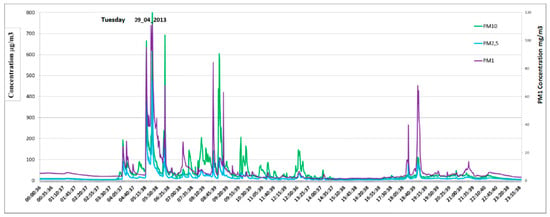
Figure 1.
Typical OPC PM10, PM2.5 and PM1 concentration trend during a working day (09 April 2013) in the bakery.
PM10 and PM1 fractions showed a different pattern during the day, suggesting different emission sources. During the afternoon, the particle number of fine fraction increased again from 18:00, with an intense peak at about 18:45. This was due to the lighting of the gas oven. Mass concentration temporal patterns shown in Figure 1 can be considered similar for all working days.
In Figure 2a, the mean trend for the fine fraction obtained by considering all working days during the whole sampling period is shown. The bakery works from Monday to Saturday. On Sunday, it is closed. The fine fraction considered here shows the particles with an optical diameter of less than 1.10 m according to the channel threshold of the OPC, and keeping in mind the mass fractions supplied by OPC, as shown in Figure 1. The coarse fraction considered in Figure 2b shows particles with an optical diameter bigger than 1.10 m.
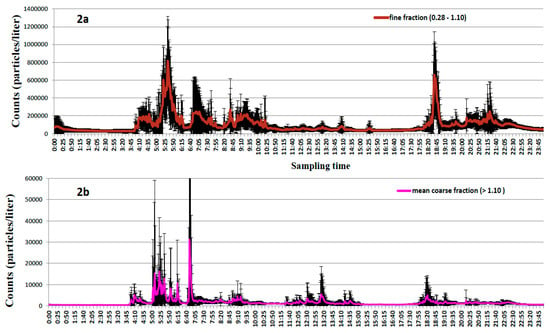
Figure 2.
(a) Mean fine fraction (0.28–1.10 μm) obtained by considering all bakery working days during the sampling period and (b) mean coarse fraction (>1.10 μm) obtained considering all bakery working days during the sampling period.
In Figure 2a, it is possible to observe a small increase in particle number starting from 4:00 that reached a maximum after 5:00 until 6:00. Afterwards, the particle count decreased even if some peaks were observed around 7:00 and 9:00. During afternoon, particle numbers of the fine fraction increased again from 18:00, with an intense peak at about 18:45.
In Figure 2b, the corresponding coarse fraction mean trend is reported. It is possible to observe a light increase in coarse particle count starting from about 4:00. The counts reached higher values at approximately 5:00 to 7:00, but these values were considerably lower than what was observed for the finer fraction. In this sampling time interval, the peaks reached 30,000 particles counts. In the rest of the day, a few peaks occurred around 9:00, 13:00 and 18:00, but the peak value did not exceeded 5000 counts. In the afternoon, at about 17:00, the bakery activities start again, mostly for afternoon production and sale (see discussion section for more details).
In Figure 3, the fine fraction mean during nonworking days (two Sundays) is shown. The fine fraction peaks between 12:00 and 13:30 were due to the wood oven turned on by the baker to cook lasagne (a typical Italian dish) for her family lunch during the first Sunday of sampling campaign.

Figure 3.
Fine fraction (0.28–1.10 µm) mean obtained for the bakery nonworking days (Sundays) during sampling period.
Observing Figure 4, coarse fraction peaks in Sunday morning revealed the presence of the baker for some light cleaning activities, as he himself reported. In addition, the increase of the coarse fraction between 11:30 and 13:40 was due to the presence of the baker in the laboratory (see Figure 2b).
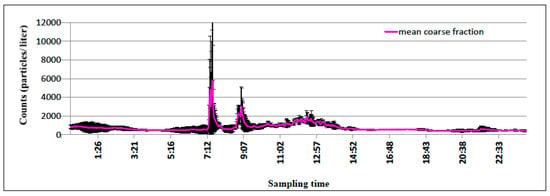
Figure 4.
Coarse fraction (>1.10 µm) mean obtained by considering all bakery nonworking days (Sundays) during sampling period.
In Figure 5, the PM2.5/PM10 mean concentration ratio during all sampling intervals per day is shown for the first week of sampling. PM2.5 and PM10 mean values were obtained from OPC data considering the four sampling intervals, that is, 3:00–9:00, 9:00–15:00, 15:00–21:00 and 21:00–3:00. For brevity, the corresponding trend plot for the second sampling week is not shown because it is similar to the one for the first week.
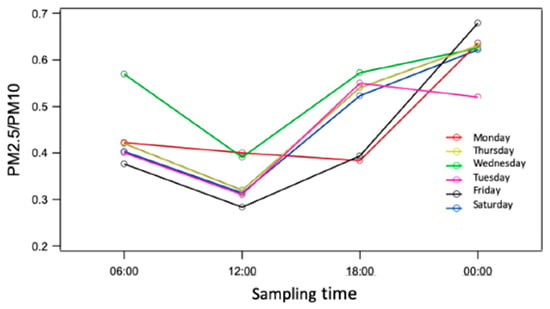
Figure 5.
PM2.5/PM10 concentration ratio during all sampling intervals for working days of the first week of sampling.
Observing Figure 5, the PM2.5/PM10 concentration ratio per sampling time was rather similar for the six days considered, except for a few cases, such as Wednesday during the first sampling time. Concerning this, it is needed to keep in mind that major bakery activities were repeated every day, but during particular days other activities such as taralli or friselle (typical local breads) production were included.
At the beginning of the working day, PM2.5/PM10 ratio suggests the relevance of fine particulate, probably due to the oven’s functioning and thus to the combustion processes. In the second interval, the ratio decreased, probably due to the continuous use of flour during morning activities. Flour and water vapor, due to their size, contribute to the coarse fraction of PM. In the second part of the day, after 14:00, the working activities and flour use decreased. This resulted in decreasing coarse particles and thus in the increasing PM2.5/PM10 ratio. In the fourth sampling interval (21:00–3:00), when the bakery was closed, the PM2.5/PM10 ratio showed the higher values due to the fact that flour and water vapor particles were deposited, while fine particles due to the oven’s combustion stayed in suspension.
3.3. PM2.5 Chemical Composition
In Figure 6, the percentage chemical composition of PM2.5 for each sampling interval is shown. It is possible to note that the percentage quantity of the carbonaceous fraction was high during the first sampling interval (3:00–9:00) and decreased until it stabilized in the following intervals, according to the more intense activity of the ovens in early morning hours.
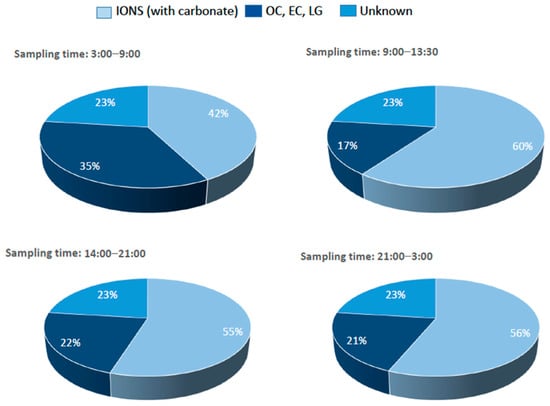
Figure 6.
The percentage chemical composition of PM2.5 in the different sampling intervals.
The speciation of the carbonaceous fraction in OC, EC and LG is highlighted in Figure 7. It is possible to note that OC, EC and LG mean concentrations monitored during the first sampling interval, when the ovens were switched on, were larger than those in the other intervals.
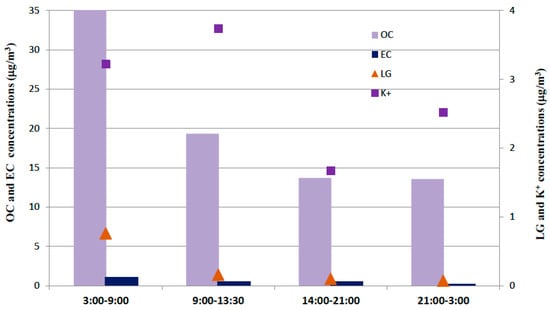
Figure 7.
OC, EC, LG and K+ mean concentrations for each sampling interval.
4. Discussion
Most bakery production occurred during the first and second sampling interval, together with the lighting of both gas and wood ovens. This resulted in the production of coarse particulates mainly made of flour and water, and finer particulate due to the combustion process of the ovens. During the third sampling period, only a short lighting of the gas oven for the afternoon production and cleaning activities occurred. The fourth sampling interval corresponded to the closure hours of the bakery. In particular, fine and coarse fractions showed an increase starting from when the ovens were first lit. Observing Figure 1 and Figure 2a,b, it is possible to note that the particle coarse fraction was mostly due to the handling of the raw materials, wood oven cleaning activities and the presence of humans in the bakery. Particulate fine fraction can be linked mainly to the combustion processes and food cooking. Major bakery activities were repeated every day. Sometimes a small time shift (30 min) occurred from day-to-day. Moreover, during particular days, other activities such as taralli or friselle (typical local breads) production were added.
As noted, PM2.5 sampling was scheduled in order to sample according to the different kinds of activities performed in the bakery.
Indoor PM2.5 mean concentration (see Table 1) was larger than outdoors suggesting dominant indoor sources for PM2.5. Even if indoor PM2.5 mean concentrations values were bigger than outdoor values, they were lower than the threshold-limit value–time-weighted average (TLV–TWA), which is the exposure limit based on the average amount of a chemical substance that a worker is exposed to over a 40 h workweek (eight hour workdays) reported in the American Conference of Governmental Industrial Hygienists (ACGIH) (2018) []. These limits correspond to 3 mg/m3 PM respirable, 10 mg/m3 PM inhalable and 0.5 mg/m3 PM2.5 for flour dust.
It is worth noting that in our PM2.5 samples, among ions, Ca2+, K+ and SO42− were the more abundant concentrations in the first and second intervals (see Table 2). It is also worth noticing that higher potassium concentrations were associated with higher nitrate during wood combustion processes (i.e., during the first and the second intervals) in accordance with literature reports [,]. Furthermore, potassium sulfate is one of the most abundant gas phase species that forms during biomass combustion [,]. In another study in the literature, it is reported how volatile ash-forming elements in wood fuels are mainly alkali metals, chlorine and sulfur, and among the ash compounds measured there are potassium, sulfates, chlorides and carbonates []. In our case, the higher Cl− concentration was registered during the first interval.

Table 2.
Mean concentration and standard deviation for monitored ions in PM2.5 samples during the four sampling intervals.
As shown in Figure 6 and Figure 7, the PM2.5 carbonaceous components represent a relevant part particularly during the first sampling interval (3:00–9:00). During other sampling intervals both absolute and percentage values decreased about 20%, according to the more intense activity of the ovens in early morning hours. Table 3 shows EC, OC and K+ mean concentrations in outdoor PM2.5 samples collected at monitoring sites close to the bakery location. Note that indoor OC mean values were bigger than outdoor ones, indoor EC mean values were similar to outdoor ones, and indoor K+ mean values were bigger than outdoor ones.

Table 3.
OC, EC and K+ mean values in outdoor PM2.5 samples and indoor (bakery) PM2.5 samples.
The different indoor-to-outdoor concentration ratio between the combustion markers may be due to the higher coarse contribution of OC and K+ with respect to EC in indoor compared to outdoor ambient air. Literature reports observe that EC represents an important component of PM2.5 mass concentration indoors and in chimney exhaust. Among elements, potassium, chlorine and sulfur are the most relevant in terms of concentration. Furthermore, EC coming from the burning of biomass is characterized by a smaller size and is related to adverse effects on human health, beyond being an important agent in climatic change [].
The correlation matrices of the PM2.5 chemical components in the four sampling intervals (not shown), and in particular the analysis of correlations for OC with other components, may give insights about transformations of organic carbon in fine particulate occurring during the day. In fact, in the first sampling interval (3:00–9:00) a significant correlation (0.70) of OC with LG was observed. LG is a compound directly linked to the emission of biomass combustion. Instead, in the second sampling interval (9:00–13:30), OC was found to show the highest correlation with K+ (0.85), as well as with other inorganic components of the PM. This could indicate a process leading to the formation of a particulate in which the inorganic and carbonaceous components were more intimately linked together. Moreover, although LG and K+ were both combustion markers, they showed different time trends as shown in Figure 7. LG concentrations progressively decreased from the first to the fourth sampling interval, while a maximum was observed for K+ concentration in the second one (9:00–13:30). Finally, the significant correlations of OC with HCOO− (0.70) in the third sampling interval (14:00–21:00) and with C2O42− (0.77) in the fourth sampling interval (21:00–3:00) may support the hypothesis of an aging process of the OC (oxidation) in the hours of the day when the combustion sources were no longer active.
Moreover, observing the mean values of LG/K+ ratio shown in Table 4 for the different sampling intervals, it is evident that the ratio in the first sampling interval was bigger than in the other intervals. In fact, during the first sampling interval, when the wood oven was switched on, LG concentrations were higher. At about 8:00, cleaning of wood oven and ash removal took place; the LG source was switched off and its concentrations in the second, third and fourth intervals were lower with a consequential decrease of the LG/K+ ratio.

Table 4.
Mean value and standard deviation of the LG/ K+ ratio in each sampling interval.
In the second sampling interval, K+ mean concentration showed an increase and the LG/K+ ratio decreased to 0.05. The K+ mean concentration trend during the first and second sampling intervals suggests a relevant second source emission of K+, that of flour. As shown in Table 5, potassium is among the micronutrients present in the flour, one of the most relevant. Moreover, potassium contained in flour is soluble. Taking this into account, the high correlation between OC and K+ could be due to the organic constituents (such as starch and fibers) derived from flour.

Table 5.
Micronutrients (as ions) present in 100 g of some kind of frumento flour (INRAN-Istituto Nazionale di Ricerca per gli Alimenti e la Nutrizione, 2000) [].
If we consider the daily K+ concentrations during the second sampling interval (9:00–13:30), as shown in Figure 8, it is possible to note that PM2.5 samples collected during 13 and 19 April showed significantly higher potassium concentrations than the other days. This can be explained by considering that on Saturday, 13 April, the bakery produced more bread (using about a double quantity of flour compared to the other working days) due to a major bread request. During the morning of 19 April, more flour was used because of the production of taralli (with a larger quantity of flour, about 16 kg more), for which the flour is used for sprinkling.
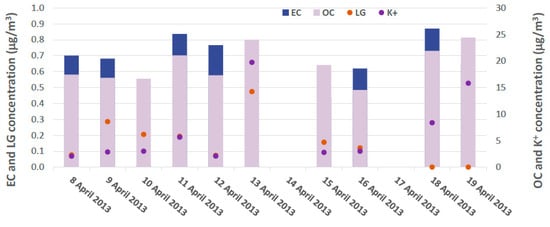
Figure 8.
LG, EC, OC and K+ concentrations during the second sampling interval for all sampling days. On 7, 14 and 17 April some problems occurred with the sampling system and these filters were not considered.
5. Conclusions
Within this paper, aerosol particulate matter emissions (PM2.5) within a bakery were studied both from the point of view of the chemical composition (ions, levoglucosan and carbonaceous components) and from the point of view of the particle size distribution. The main sources of particles were wood burning (in correspondence with the interval time when the wood oven was switched on), the cleaning of ovens (ash removal), and the baking of bread. The latter was responsible for the emission of fine particles while the wood combustion was associated with both coarse and fine fraction particles. While levoglucosan was associated with a wood burning source, potassium in this case can be considered as a marker of the contribution of the bakery activities.
Author Contributions
Conceptualization, P.I.; methodology, P.F. and P.I.; software, A.G.; validation, V.A., V.F.U. and C.M.P.; formal analysis, P.F.; investigation, P.I., V.F.U.; data curation, P.F. and V.A.; writing—original draft preparation, P.I. and P.F.; writing—review and editing, A.G.; visualization, C.M.P.; supervision, P.I. All authors have read and agreed to the published version of the manuscript.
Funding
This research received no external funding.
Acknowledgments
Authors wish to thank Antonio Imperatore for FAI Instruments s.r.l. and Franco Colacicco for bakery “da Teresa” for their willingness to facilitate our research and technical support.
Conflicts of Interest
The authors declare no conflict of interest.
References
- Ielpo, P.; Taurino, M.R.; Buccolieri, R.; Placentino, C.M.; Gallone, F.; Ancona, V.; Di Sabatino, S. Polycyclic aromatic hydrocarbons in a bakery indoor air: Trends, dynamics, and dispersion. Environ. Sci. Pollut. Res. 2018, 25, 28760–28771. [Google Scholar] [CrossRef]
- Koistinen, K.J.; Hänninen, O.; Rotko, T.; Edwards, R.D.; Moschandreas, D.; Jantunen, M.J. Behavioral and environmental determinants of personal exposures to PM2.5 in EXPOLIS-Helsinki, Finland. Atmos. Environ. 2001, 35, 2473–2481. [Google Scholar] [CrossRef]
- Scapellato, M.L.; Canova, C.; de Simone, A.; Carrieri, M.; Maestrelli, P.; Simonato, L.; Bartolucci, G.B. Personal PM10 exposure in asthmatic adults in Padova, Italy: Seasonal variability and factors affecting individual concentrations of particulate matter. Int. J. Hyg. Environ. Health 2009, 212, 626–636. [Google Scholar] [CrossRef] [PubMed]
- Delgado-Saborit, J.M.; Stark, C.; Harrison, R.M. Carcinogenic potential, levels and sources of polycyclic aromatic hydrocarbon mixtures in indoor and outdoor environments and their implications for air quality standards. Environ. Int. 2011, 37, 383–392. [Google Scholar] [CrossRef] [PubMed]
- Varghese, B.M.; Hansen, A.L.; Williams, S.; Bi, P.; Hanson-Easey, S.; Barnett, A.G.; Heyworth, J.S.; Sim, M.R.; Rowett, S.; Nitschke, M.; et al. Heat-related injuries in Australian workplaces: Perspectives from health and safety representatives. Saf. Sci. 2020, 126. [Google Scholar] [CrossRef]
- Madureira, J.; Slezakova, K.; Silva, A.I.; Lage, B.; Mendes, A.; Aguiar, L.; Pereira, M.C.; Teixeira, J.P.; Costa, C. Assessment of indoor air exposure at residential homes: Inhalation dose and lung deposition of PM10, PM2.5 and ultrafine particles among newborn children and their mothers. Sci. Total Environ. 2020, 717. [Google Scholar] [CrossRef] [PubMed]
- Downward, G.S.; van der Zwaag, H.P.; Simons, L.; Meliefste, K.; Tefera, Y.; Carreon, J.R.; Vermeulen, R.; Smit, L.A.M. Occupational exposure to indoor air pollution among bakery workers in Ethiopia; A comparison of electric and biomass cookstoves. Environ. Pollut. 2018, 233, 690–697. [Google Scholar] [CrossRef]
- Brant, A. Baker’s asthma. Curr. Opin. Allergy Clin. Immunol. 2007, 7, 152–155. [Google Scholar] [CrossRef]
- Jacobs, J.H.; Meijster, T.; Meijer, E.; Suarthana, E.; Heederick, D. Wheat allergen exposure and the prevalence of work-related sensitization and allergy in bakery workers. Allergy 2008, 63, 1597–1604. [Google Scholar] [CrossRef]
- Suarthana, E.; Vergouwe, Y.; Moons, K.G.; de Monchy, J.; Grobbee, D.; Heederick, D.; Meijer, E. A diagnostic model for the detection of sensitization to wheat allergens was developed and validated in bakery workers. J. Clin. Epidemiol. 2010, 63, 1011–1019. [Google Scholar] [CrossRef]
- Ade, S.; Adjobimey, M.; Agodokpessi, G.; Kouassi, M.S.; Gounongbe, F.A.; Cisse, I.; Hounkpatin, S.H.R. Asthma symptoms in bakeries at parakou, benin. Pulm. Med. 2020, 2020, 376–382. [Google Scholar] [CrossRef] [PubMed]
- Previdi, M.; Marracini, P.; Farioli, L. Allergopatie respiratorie professionali: Monitoraggio ambientale, aeroallergeni, prevenzione. Med. Lav. 1988, 89, 481–498. [Google Scholar]
- Patussi, V.; Portello, A.; Chermaz, E.; Sernagiotto, F.; De Noni, R.; Lorusso, A.; Collareta, A.; Valentini, F.; Agnesi, R.; Dal Vecchio, L.; et al. Allergic disease due to wheat flour. Allergy 1995, 26, 88. [Google Scholar]
- Geyssant, M.E.; Barthélemy, J.F.; Mouchot, L.; Paris, C.; Zmirou-Navierdoi, D. Exposure of bakery and pastry apprentices to airborne flour dust using PM2.5 and PM10 personal samplers. BMC Public Health 2007, 7, 311. [Google Scholar]
- Khan, S.; Khaskheli, M.H.; Nabi, G.; Deverajani, B.R.; Memon, N.; Shar, G.A. Immunological study of different fraction of wheat proteins. Pak. J. Pharm. Sci. 2018, 31, 1437–1440. [Google Scholar]
- Aidoo, H.; Beach, J.; Elbourne, R.; Galarneau, J.M.F.; Straube, S.; Cherry, N. Estimation and validation of flour exposure in bakeries in Alberta, Canada. Ann. Work Expo. Health 2018, 62, 1096–1108. [Google Scholar] [CrossRef] [PubMed]
- De Zotti, R.; Larese, F.; Bovenzi, M.; Negro, C.; Molinari, S. Allergic airway disease in Italian bakers and pastry makers. Occup. Environ. Med. 1994, 51, 548–552. [Google Scholar] [CrossRef] [PubMed]
- Fishwick, D.; Curran, A.D. Variability in the diagnosis of occupational asthma and implications for clinical practice. Curr. Opin. Allergy Clin. Immunol. 2008, 8, 140–144. [Google Scholar] [CrossRef] [PubMed]
- Tarlo, S.M.; Malo, J.-L. An official american thoracic society proceedings: Work-related asthma and airway diseases: Presentations and discussion from the fourth jack pepys workshop on asthma in the workplace. Ann. Am. Thorac. Soc. 2013, 10, S17–S24. [Google Scholar] [CrossRef]
- Previdi, M.; Farioli, L.; Marracini, P. Risultati delle indagini nei panifici milanesi. In Proceedings of the Rischi e Strumenti Operativi per la Prevenzione nel Settore Della Panificazione, Milan, Italy, 23 November 1998; pp. 10–15. [Google Scholar]
- Saia, B.; Baruffini, A.; Cirla, A.M. Valutazione dell’esposizione ad allergeni professionali. Acta Med. Mediterr. 1997, 135, 234–243. [Google Scholar]
- Cotton, D.J.; Dosman, J.A. Grain dust and health. III. Environmental factors. Ann. Intern. Med. 1978, 89, 420–421. [Google Scholar] [CrossRef] [PubMed]
- Cotton, D.J.; Graham, B.L.; Li, K.Y.; Froh, F.; Barnett, G.D.; Dosman, J.A. Effects of grain dust exposure and smoking on respiratory symptoms and lung function. J. Occup. Med. 1983, 25, 131–141. [Google Scholar] [PubMed]
- Hurst, T.S.; Dosman, J.A. Characterization of health effects of grain dust exposures. Am. J. Ind. Med. 1990, 17, 27–32. [Google Scholar] [CrossRef] [PubMed]
- Poulsen, K.B.; Nielsen, H.W. Health problems among persons exposed to grain dust (Review) [Helbredsgener hos personer udsat for kornstøv.]. Ugeskr Laeger 1991, 153, 1986–1990. [Google Scholar]
- Chan-yeung, M.; Dimich-ward, H.; Enarson, D.A.; Kennedy, S.M. Five cross-sectional studies of grain elevator workers. Am. J. Epidemiol. 1992, 136, 1269–1279. [Google Scholar] [CrossRef] [PubMed]
- Fonn, S.; Groeneveld, H.T.; deBeer, M.; Becklake, M.R. Relationship of respiratory health status to grain dust in a Witwatersrand grain mill: Comparison of workers’ exposure assessments with industrial hygiene survey findings. Am. J. Ind. Med. 1993, 24, 401–411. [Google Scholar] [CrossRef] [PubMed]
- Gimenez, C.; Fouad, K.; Choudat, D.; Bouscaillou, P.; Leib, E.; Laureillard, J. Chronic and acute respiratory effects among grain mill workers. Int. Arch. Occup. Environ. Health 1995, 67, 311–315. [Google Scholar] [CrossRef] [PubMed]
- Massin, N.; Bohadana, A.B.; Wild, P.; Kolopp-Sarda, M.N.; Toamain, J.P. Airway responsiveness to methacholine, respiratory symptoms, and dust exposure levels in grain and flour mill workers in eastern france. Am. J. Ind. Med. 1995, 27, 859–869. [Google Scholar] [CrossRef]
- Peelen, S.J.M.; Heederik, D.; Dimich-Ward, H.D.; Chan-Yeung, M.; Kennedy, S.M. Comparison of dust related respiratory effects in Dutch and Canadian grain handling industries: A pooled analysis. Occup. Environ. Med. 1996, 53, 559–566. [Google Scholar] [CrossRef]
- Musk, A.W.; Venables, K.M.; Crook, B.; Nunn, A.J.; Hawkins, R.; Crook, G.D.W.; Graneek, B.J.; Tee, R.D.; Farrer, N.; Johnson, D.A.; et al. Respiratory symptoms, lung function, and sensitisation to flour in a British bakery. Br. J. Ind. Med. 1989, 46, 636–642. [Google Scholar] [CrossRef]
- Hauggaard-Nielsen, H.E.; Mundus, S.; Jensen, E.S. Grass-clover undersowing affects nitrogen dynamics in a grain legume-cereal arable cropping system. Field Crop. Res. 2012, 136, 23–31. [Google Scholar] [CrossRef]
- Buonanno, G.; Morawska, L.; Stabile, L. Particle emission factors during cooking activities. Atmos. Environ. 2009, 43, 3235–3242. [Google Scholar] [CrossRef]
- Zhai, S.R.; Albritton, D. Airborne particles from cooking oils: Emission test and analysis on chemical and health implications. Sustain. Cities Soc. 2020, 52. [Google Scholar] [CrossRef]
- El-Sharkawy, M.F.; Javed, W. Study of indoor air quality level in various restaurants in Saudi Arabia. Environ. Prog. Sustain. Energy 2018, 37, 1713–1721. [Google Scholar] [CrossRef]
- Massey, D.; Kulshrestha, A.; Masih, J.; Taneja, A. Seasonal trends of PM10, PM5.0, PM2.5 & PM1.0 in indoor and outdoor environments of residential homes located in North-Central India. Build Environ. 2012, 47, 223–231. [Google Scholar]
- Dario, R.; Uva, J.; Trani, G.; Falco, S.; Ancona, V.; Petrera, L. Evaluation of the dustiness of a Bakery: An integrated system with an experimental electronic device. G. Ital. Med. Lav. Ergon. 2012, 34, 744–747. [Google Scholar]
- Salthammer, T.; Schripp, T.; Wientzek, S.; Wensing, M. Impact of operating wood-burning fireplace ovens on indoor air quality. Chemosphere 2014, 103, 205–211. [Google Scholar] [CrossRef]
- Daellenbach, K.R.; Stefenelli, G.; Bozzetti, C.; Vlachou, A.; Fermo, P.; Gonzalez, R.; Piazzalunga, A.; Colombi, C.; Canonaco, F.; Hueglin, C.; et al. Long-term chemical analysis and organic aerosol source apportionment at nine sites in central Europe: Source identification and uncertainty assessment. Atmos. Chem. Phys. 2017, 17, 13265–13282. [Google Scholar] [CrossRef]
- Li, S.; Gao, J.; He, Y.; Cao, L.; Li, A.; Mo, S.; Chen, Y.; Cao, Y. Determination of time- and size-dependent fine particle emission with varied oil heating in an experimental kitchen. J. Environ. Sci. 2017, 51, 157–164. [Google Scholar] [CrossRef]
- Ielpo, P.; Fermo, P.; Comite, V.; Mastroianni, D.; Viviano, G.; Salerno, F.; Tartari, G. Chemical characterization of biomass fuel particulate deposits and ashes in households of Mt. Everest region (NEPAL). Sci. Total Environ. 2016, 573, 751–759. [Google Scholar] [CrossRef]
- Cattaneo, A.; Fermo, P.; Urso, P.; Perrone, M.G.; Piazzalunga, A.; Tarlassi, J.; Carrer, P.; Cavallo, D.M. Particulate-bound polycyclic aromatic hydrocarbon sources and determinants in residential homes. Environ. Pollut. 2016, 218, 16–25. [Google Scholar] [CrossRef] [PubMed]
- Gibbs, R.; Whitby, R.; Johnson, R. Experimental measurement of particulate emissions from a diesel operated with particulate laden intake air. In Proceedings of the Chemical and Physical Processes in Combustion, Fall Technical Meeting, the Eastern States Section, Philadelphia, PA, USA, 4–6 November 1985; p. 84. [Google Scholar]
- Armstrong, B.; Hutchinson, E.; Unwin, J.; Fletcher, T. Lung cancer risk after exposure to polycyclic aromatic hydrocarbons: A review and meta-analysis. Environ. Health Perspect. 2004, 112, 970–978. [Google Scholar] [CrossRef] [PubMed]
- Fermo, P.; Piazzalunga, A.; Vecchi, R.; Ga, V. Set-up of extraction procedures for ions quantification in aerosol samples. Chem. Eng. Trans. 2006, 10, 203–208. [Google Scholar]
- Piazzalunga, A.; Bernardoni, V.; Fermo, P.; Vecchi, R. Optimisation of analytical procedures for the quantification of ionic and carbonaceous fractions in the atmospheric aerosol and applications to ambient samples. Anal. Bioanal. Chem. 2013, 405, 1123–1132. [Google Scholar] [CrossRef]
- Fermo, P.; Piazzalunga, A.; Vecchi, R.; Valli, G.; Mb, C. A TGA/FT-IR study for measuring OC and EC in aerosol samples. Atmos. Chem. Phys. 2006, 6, 255–266. [Google Scholar] [CrossRef]
- Piazzalunga, A.; Belis, C.; Bernardoni, V.; Cazzuli, O.; Fermo, P.; Valli, G.; Vecchi, R. Estimates of wood burning contribution to PM by the macro-tracer method using tailored emission factors. Atmos. Environ. 2011, 45, 6642–6649. [Google Scholar] [CrossRef]
- Genga, A.; Ielpo, P.; Siciliano, M.; Siciliano, T. Carbonaceous particles and aerosol mass closure in PM2.5 collected in a port city. Atmos. Res. 2017, 183, 245–254. [Google Scholar] [CrossRef]
- Cuccia, E.; Massabò, D.; Ariola, V.; Bove, M.C.; Fermo, P.; Piazzalunga, A.; Prati, P. Size-resolved comprehensive characterization of airborne particulate matter. Atmos. Environ. 2013, 67, 14–26. [Google Scholar] [CrossRef]
- American Conference of Governmental Industrial Hygienists (ACGIH). 2018. TLVs and BEIs. Available online: https://www.acgih.org/ (accessed on 28 September 2018).
- Luo, L.; Wu, Y.; Xiao, H.; Zhang, R.; Lin, H.; Zhang, X.; Kao, S.-J. Origins of aerosol nitrate in Beijing during late winter through spring. Sci. Total Environ. 2019, 653, 776–782. [Google Scholar] [CrossRef]
- Benetello, F.; Squizzato, S.; Hofer, A.; Masiol, M.; Khan, M.B.; Piazzalunga, A.; Fermo, P.; Formenton, G.M.; Rampazzo, G.; Pavoni, B.; et al. Estimation of local and external contributions of biomass burning to PM2.5 in an industrial zone included in a large urban settlement. Environ. Sci. Pollut. Res. 2017, 24, 2100–2115. [Google Scholar] [CrossRef]
- Torvela, T.; Tissari, J.; Sippula, O.; Kaivosoja, T.; Leskinen, J.; Virén, A.; Lähde, A.; Jokiniemi, J. Effect of wood combustion conditions on the morphology of freshly emitted fine particles. Atmos. Environ. 2014, 87, 65–76. [Google Scholar] [CrossRef]
- Shah, K.V.; Cieplik, M.K.; Betrand, C.I.; van de Kamp, W.L.; Vuthaluru, H.B. Correlating the effects of ash elements and their association in the fuel matrix with the ash release during pulverized fuel combustion. Fuel Process. Technol. 2010, 91, 531–545. [Google Scholar] [CrossRef]
- Tissari, J.; Lyyränen, J.; Hytönen, K.; Sippula, O.; Tapper, U.; Frey, A.; Saarnio, K.; Pennanen, A.S.; Hillamo, R.; Salonen, R.O.; et al. Fine particle and gaseous emissions from normal and smouldering wood combustion in a conventional masonry heater. Atmos. Environ. 2008, 42, 7862–7873. [Google Scholar] [CrossRef]
- Mota Lima, F.D.; Pérez-Martínez, P.J.; Andrade, M.d.F.; Kumar, P.; de Miranda, R.M. Characterization of particles emitted by pizzerias burning wood and briquettes: A case study at Sao Paulo, Brazil. Environ. Sci. Pollut. Res. 2020. [Google Scholar] [CrossRef]
- Infofarine. Available online: http://www.infofarine.it/le-proprieta-nutrizionali/ (accessed on 12 December 2015).
© 2020 by the authors. Licensee MDPI, Basel, Switzerland. This article is an open access article distributed under the terms and conditions of the Creative Commons Attribution (CC BY) license (http://creativecommons.org/licenses/by/4.0/).